Protect your property and Colorado’s forests with professional fire mitigation services. Splintered Forest specializes in reducing wildfire risk through strategic tree removal, defensible space creation, and expert assessment to keep your home and community safer.
Wildfires are an ever-present threat in Colorado, especially for those living in the wildland-urban interface (WUI). Creating and maintaining defensible space around your property is a critical step in safeguarding your home and community. Here’s what you need to know to get started.
As wildfires have become more frequent and more destructive in recent years in Colorado. Whether you’re located in the foothills, nestled in the forest, or near the wildland-urban interface, fire mitigation is no longer optional—it’s essential. At Splintered Forest, we help Colorado homeowners reduce their wildfire risk through professional defensible space inspections, strategic fire mitigation, and forestry services.
Defensible space refers to the buffer zone you create between a building and the grass, trees, shrubs, or wildland area that surrounds it. This space is designed to slow or stop the spread of wildfire and protect your home from direct flame contact, radiant heat, and ember intrusion.
Creating a defensible space isn’t just about trimming branches. It’s about zoning your property into three strategic areas—each requiring specific treatment.
Regular Maintenance: Continuously monitor and maintain your defensible space, especially during fire season.
Home Hardening: Use fire-resistant building materials for roofs, siding, and decks. Install ember-resistant vents and screens.
Community Engagement: Participate in local fire mitigation programs and stay informed about fire risks in your area.
Wildfires are an increasing threat across Colorado’s Front Range. As our communities grow closer to wild land areas, the need for proactive fire mitigation has never been more urgent. At Splintered Forest Tree Services, we specialize in helping homeowners, HOAs, and property managers reduce wildfire risks by creating and maintaining defensible space—a proven method for protecting structures from wildfire damage.
Defensible space is the area between a building and the surrounding vegetation that’s strategically managed to reduce fire danger. Creating this buffer slows the spread of wildfire, reduces fuel, and provides firefighters with a safe zone to defend your home.
The Colorado State Forest Service and Wildfire Partners recommend a zoned approach, dividing your property into three defensible zones based on their proximity to your home.
Remove all flammable vegetation and debris.
Relocate firewood, mulch, and outdoor furniture made from combustible materials.
Clean gutters and roofs regularly to remove pine needles and dry leaves.
Use non-flammable landscaping such as gravel, stone, or pavers.
Space trees at least 10 feet apart and prune lower branches.
Remove ladder fuels (vegetation that allows fire to climb from ground to canopy).
Keep grass mowed to under 4 inches.
Create breaks with hardscaping like patios or driveways.
Thin out dense trees and shrubs to reduce overall fuel load.
Remove dead trees, fallen branches, and leaf litter.
Maintain clear access for emergency vehicles.
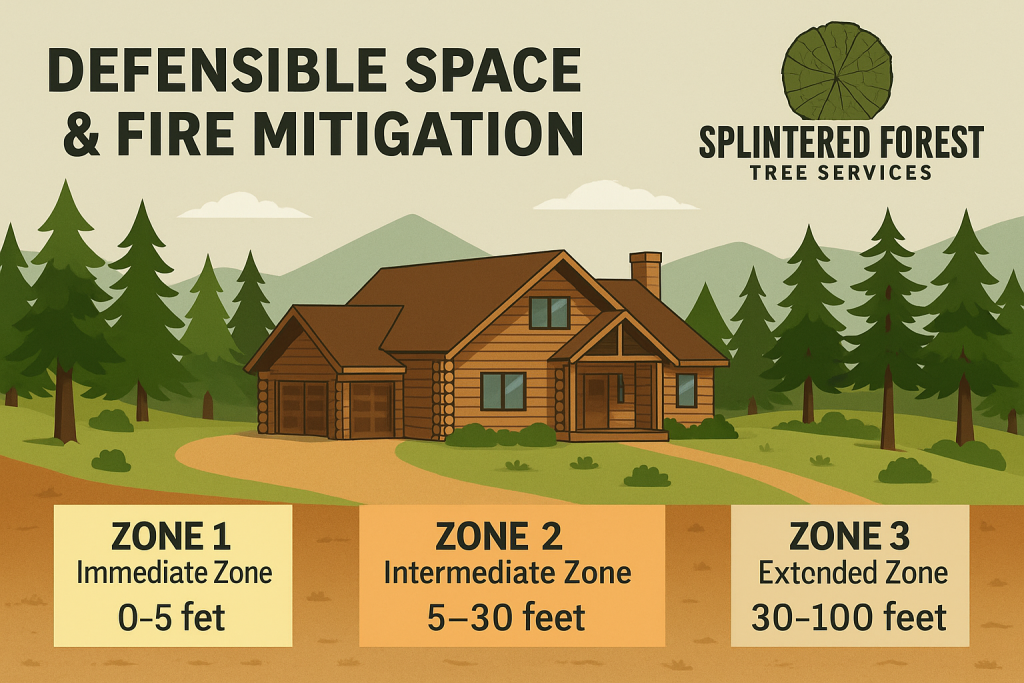
Colorado’s arid climate, wind-prone weather, and dry vegetation make it highly susceptible to fast-moving wildfires. Many homes lost to wildfire are ignited by embers, not direct flames—meaning preparation around your home’s perimeter is crucial.
Defensible space isn’t just a suggestion—it’s often required. Many counties in Colorado now require fire mitigation inspections for new construction, property sales, or insurance compliance. Splintered Forest offers county-approved defensible space assessments that meet local regulations and help you stay compliant.
To check out more wildfire mitigation basics and resources visit Colorado WILDFIRE PARTNERS!
A fire mitigation inspection from Splintered Forest includes:
We follow Firewise Colorado and national safety standards to ensure every property meets or exceeds wildfire readiness guidelines.
We also work with property managers, apartment complexes, and HOAs throughout the Front Range to create fire-adapted communities. If you manage multiple residences, creating a long-term mitigation plan is essential to protect not only property, but lives. We provide:
Bulk defensible space clearing
Hazardous tree removals
Fire mitigation planning
Ongoing maintenance contracts
Our certified arborists understand more than just tree removal—we know how to assess risk based on slope, tree species, wind exposure, and your property’s layout. We don’t just clear land—we build fire-resilient landscapes. Our team works hand-in-hand with local regulations and wildfire mitigation programs, making us a trusted partner in high-risk areas.
Any structure exposed to fire risk, including homes, garages, decks, and sheds.
Our Defensible Space Inspectors (DSI) will mark and measure this for you during your site visit.
It varies by tree density, slope, and accessibility. We also help clients take advantage of Colorado fire mitigation tax credits and wildfire mitigation grants.
Here’s your quick action list:
Splintered Forest offers complete fire mitigation services for Colorado’s Front Range and foothills, including Golden, Evergreen, Conifer, and surrounding communities.
Wildfire season isn’t waiting. Whether you live in Evergreen, Conifer, Boulder, or anywhere in Colorado’s Front Range, creating a defensible space could make all the difference when a fire sparks. Our team of certified arborists and fire mitigation specialists is trained in Firewise practices, fire zoning, and wildfire defense. Whether you need a full-service plan or just want a second opinion, we’re here to help keep your property safe.
Contact Splintered Forest Tree Services today to schedule a defensible space assessment or get help navigating local fire mitigation requirements.
At Splintered Forest Tree Services, we specialize in creating defensible spaces tailored to your property’s unique needs. Our certified arborists provide:
Comprehensive assessments of your property’s fire risk.
Customized plans to establish and maintain defensible space.
Assistance with local regulations and compliance.
Protect your home. Create defensible space. Schedule your fire mitigation inspection with Splintered Forest today.
From Egg to Invading: The Full Emerald Ash Borer Life Cycle
The Emerald Ash Borer or more commonly referred to as EAB goes through many cycles before emerging as a mature adult. Continue reading to learn more about each part of the invasive pests life cycle.
The life cycle of the emerald ash borer repeats annually:
Understanding this cycle is key to preventing infestations and maintaining the health of ash trees. The emerald ash borer life cycle is synchronized with seasonal changes, meaning effective management must be timed correctly.
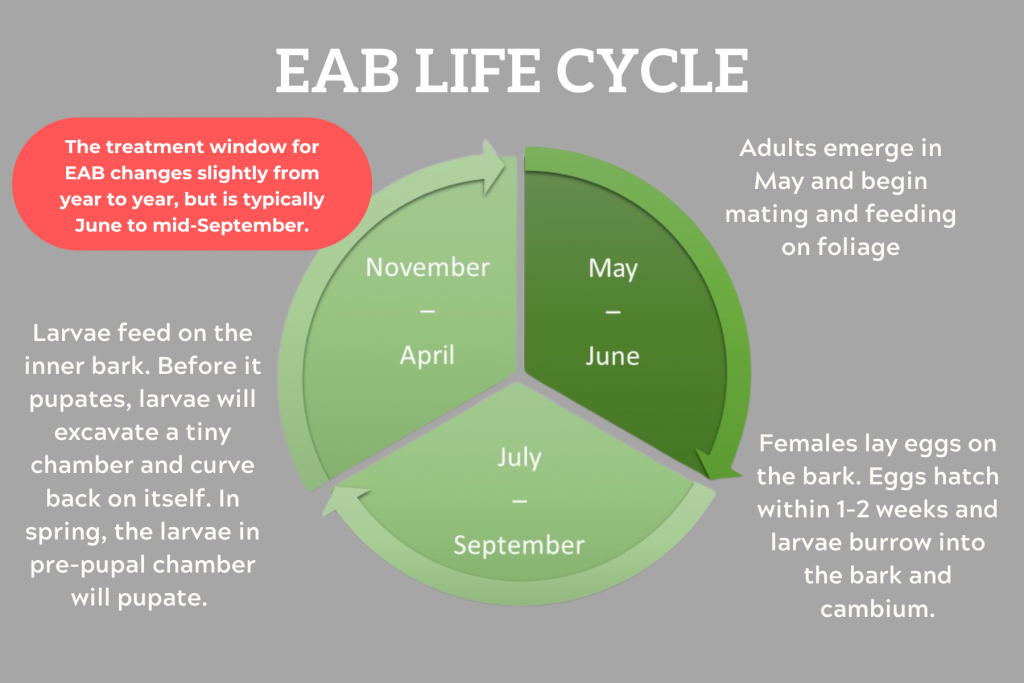
Eggs are approximately 1mm in size and laid by females in the cracks and crevices of the bark of ash trees. Females can lay anywhere from 40 to 200 eggs that will hatch about two weeks later. Upon hatching the larvae will then burrow into the trees inner bark layers and begin to feed.
The emerald ash borer egg is a critical but often overlooked stage in the EAB life cycle. These eggs:
Since EAB eggs hatch quickly, preventive treatments should be applied in early spring before larvae emerge.
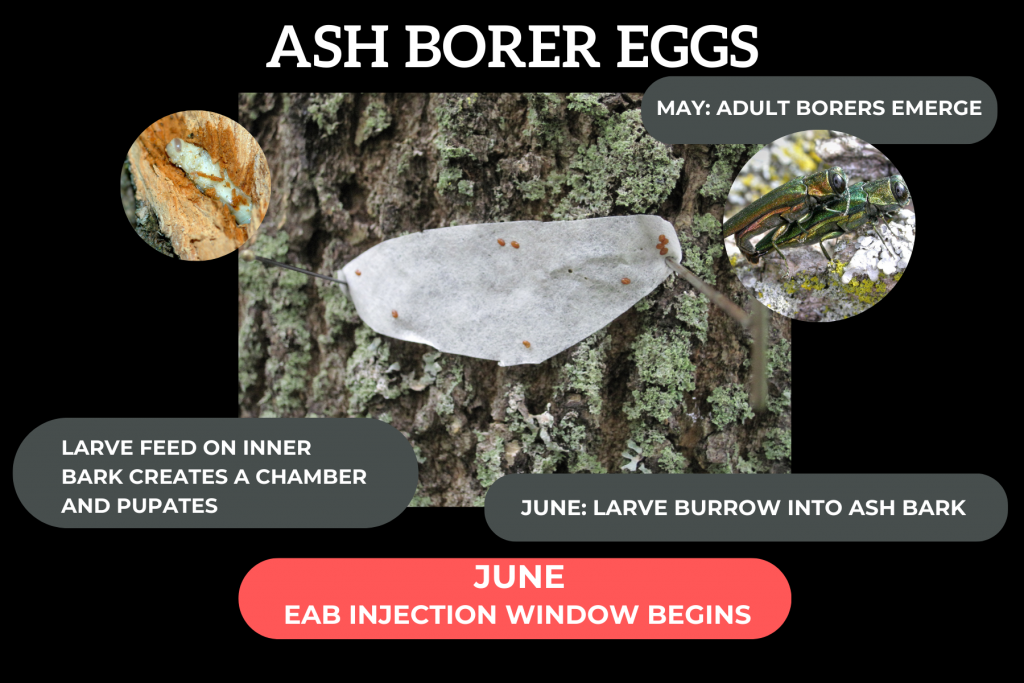
The larval stage is the most dangerous stage of the beetles life. Larvae tunnel into the bark upon hatching from their eggs. They then spend all of their time eating tissues that the tree would need to transport water and nutrients. This damage of vital tissues can quickly become deadly to the ash tree because of the number of larvae doing damage and their aggressive nature. As they feed their movements form a distinct S-shaped pattern which can be seen when bark is removed. This is the stage most often selected to chemically treat an infestation as the larvae will feed on treated wood and then die.
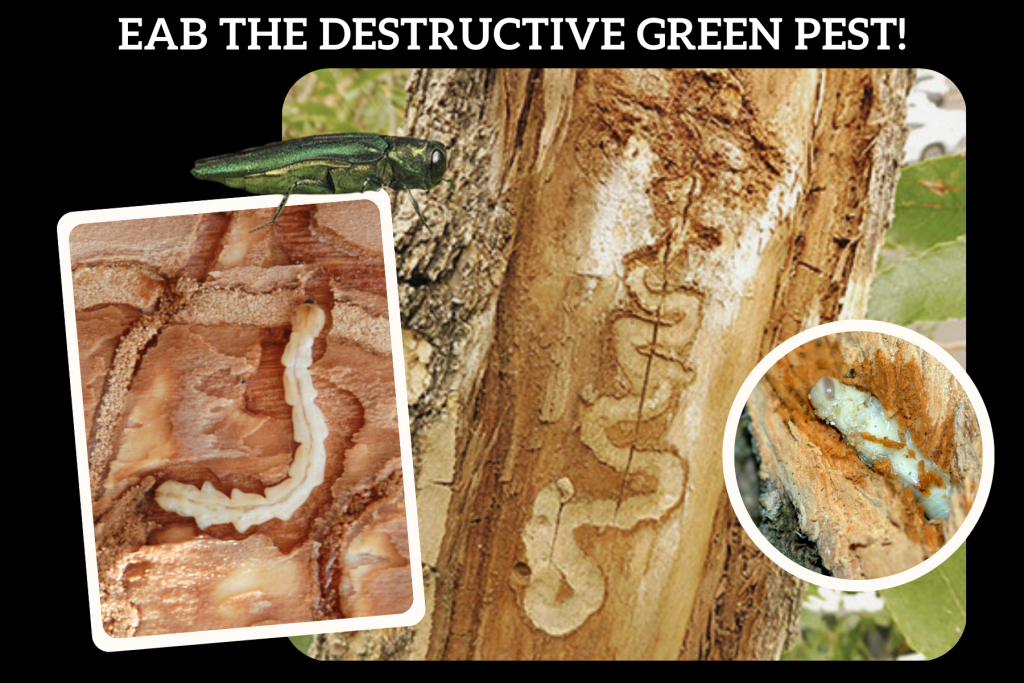
The emerald ash borer larva is the most damaging stage of the EAB life cycle.
Once larvae are present, systemic insecticides or tree removal may be the only options.
Overwinter
After feeding on tree matter for one to two years, the larvae will overwinter and begin to pupate in the spring. This overwintering in the tree keeps the larvae and pupae safe from cold weather and potential predators.
Pupae
The pupa is the final form before emerging as a mature adult. It merely is a stage to facilitate metamorphosis to the final adult beetle stage.
Adults
Adults can emerge any time between late-May and September, but the majority of them will emerge by July and begin to mate and lay eggs. As they exit, they form D-shaped exit holes which can be used to identify the beetle’s presence in a tree. The adult form does minimal damage to the tree as they usually feed on the leaves of the tree and mate before dying, but their ability to fly up to a quarter mile aids in their spread.
The Emerald Ash Borer (EAB) poses a significant threat to ash trees, causing extensive damage throughout its life cycle. Recognizing the signs, exploring treatment options, and understanding preventive measures are crucial for preserving these valuable trees.
Identifying signs of EAB damage is vital for early intervention. Look for distinct D-shaped exit holes left by emerging adults, as well as canopy thinning, bark splits, and epicormic shoots—new growth arising from the tree’s base or trunk. Recognizing these indicators early can be instrumental in minimizing the impact on ash trees.
Timely treatment is essential to combat EAB infestations. Various methods, including chemical treatments and insecticides, are available. Chemical treatments during the larval stage can effectively control the population by targeting feeding larvae. Consulting with arborists or plant health care professionals is recommended to determine the most suitable treatment approach for specific situations.
Implementing preventive measures is crucial in areas prone to EAB infestations. Regular inspections, early detection, and prompt treatment can help protect ash trees. Consider systemic insecticides that are absorbed by the tree, providing long-term protection against EAB. Establishing a proactive treatment plan can significantly enhance the resilience of ash trees.
Stay informed about the geographical distribution of EAB through maps tracking its presence. Understanding the areas affected can guide proactive measures and help prevent the spread of this invasive species.
Knowing where the EAB originated is essential for understanding its introduction to new regions. The beetle is native to Asia and likely arrived in the United States through international trade. Tracking its spread provides valuable insights for managing and mitigating its impact.
Colorado, including the Denver Metro area, has witnessed the invasion of EAB. Being aware of local infestations, understanding treatment costs, and collaborating with professionals is crucial for effective management.
Examining the transformation of ash trees before and after EAB damage showcases the severity of infestations. Utilizing visual aids, such as damage maps, illustrates the impact and emphasizes the importance of proactive measures.
Distinguishing between EAB and similar-looking beetles is essential for accurate identification and treatment. Identify EAB look-a-likes:
See the University of Nebraska EAB Look-a-likes chart. EAB adults are smaller than a penny approximately 8-13 mm long. They are about the size of a cooked grain of rice: between 3/8- and 1/2-inch long and 1/16-inch wide. Due to their size, they can often go undetected, but they can be seen on ash bark and leaves during warmer months, at this time they might attract woodpecker activity.
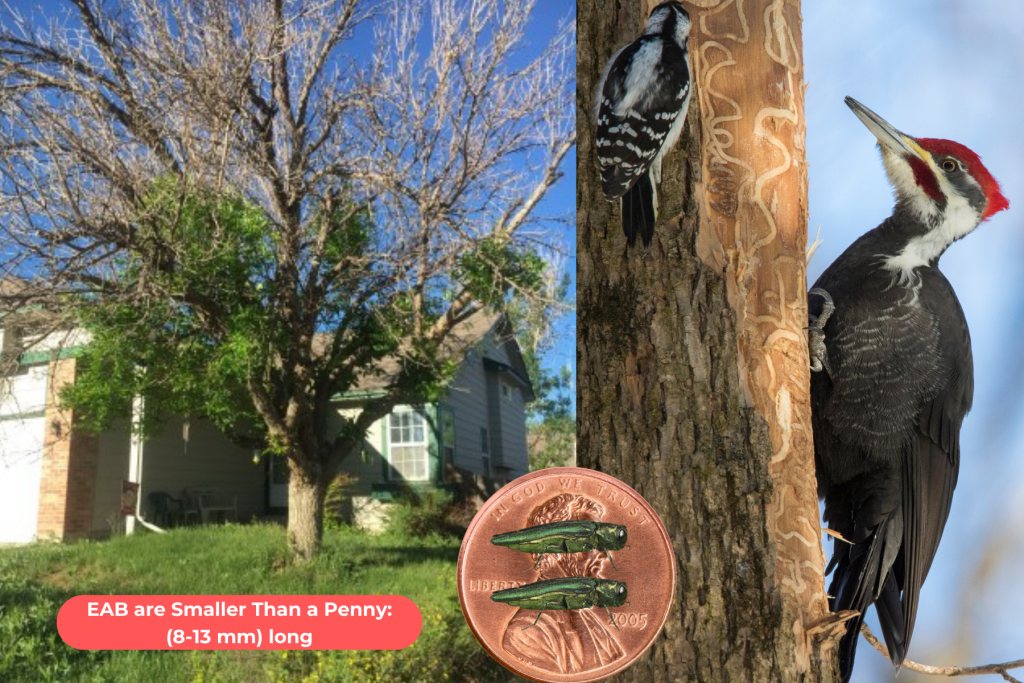
Do you live in the Denver Metro area? Do you have an ash tree on your property? The EAB has been detected most recently in the Littleton area and continues to spread. Contact the team of Plant Health Care professionals at Splintered Forest to create a maintenance plan to protect your landscape today! Give us a call at 303-819-9840 extension 1 or visit us online to submit your request for a free estimate.
Read more about the impact of the emerald ash borer (EAB) on local ecosystems is a growing concern for Colorado residents.
Learn the best practices for protecting Ash trees from EAB and ensuring their long-term health.
Interested in EAB Injections for your ash trees. In our next post we break down the science of THE EAB INJECTION PROCESS.
Schedule Now at Save My Ash.
In the realm of evergreen trees, the distinction between spruces, pines, firs, and Douglas firs may seem elusive, as they share the timeless allure of coniferous beauty. However, subtle differences in needle arrangements, textures, and cone characteristics provide valuable clues to unveil the identity of these majestic trees on your property.
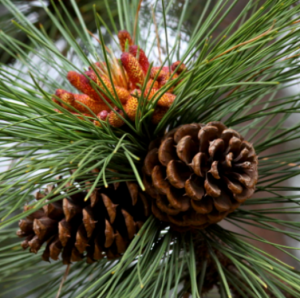
Pine trees are characterized by needle clusters ranging from 2 to 5, depending on the species. Notably, pines never exhibit singular needles. Distinguishing them further, pines boast canopies with less dense needle coverage compared to firs and spruces. Examining their cones reveals a sturdier and more woody texture compared to their coniferous counterparts.
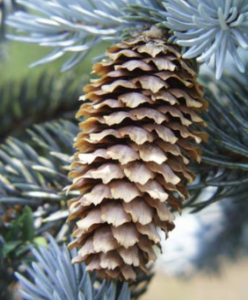
Spruces stand out with needles that emerge individually from the branch, presenting a singular, squared appearance. Run your fingers along spruce needles, and you’ll notice their sharp points. Additionally, the needles of spruces can be easily rolled between your fingers, enhancing their distinct texture. When observing their cones, spruces exhibit a softer feel and thinner scales, giving them a more flexible and bendable nature.
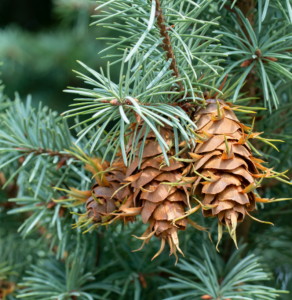
Both Douglas-fir and true fir trees share the characteristic of having singular needles extending from the branch. However, distinguishing between them involves the texture of the needles. Fir needles are flat and lack the rigidity found in spruce needles. Unlike spruces, fir needles are not easily rolled between your fingers, offering a softer touch. When handling their cones, firs display a similar flexibility, featuring softer scales that set them apart from the sturdier cones of pines. Fir cones also have a bract that sticks down between the scales which makes them distinctive.
Understanding these nuanced differences in coniferous trees becomes not only an aesthetic pursuit but also a practical skill. Identifying these evergreens proves valuable when planning landscape designs or seeking arborist advice on potential pests and diseases that may impact them. With this knowledge, you can embark on a journey of appreciating and caring for the diverse tapestry of evergreen wonders that grace your surroundings.
Hardwood and softwood, while terms often associated with the density of wood, actually refer to two distinct types of trees. Hardwoods come from deciduous trees that shed their leaves annually, such as oak, maple, and cherry. Softwoods, on the other hand, are derived from coniferous, evergreen trees like pine, spruce, and cedar. The distinction between the two lies in the structure of the trees and the types of seeds they produce rather than the hardness of the wood.
Hardwoods are known for their dense and durable composition, making them well-suited for a variety of applications. Commonly used in furniture construction, hardwoods contribute to pieces with a timeless and sturdy quality. Oak, for instance, is prized for its strength and beautiful grain patterns. Maple is favored for its light color and fine texture, often used in cabinets and flooring. In contrast, softwoods, with their more porous and lightweight characteristics, find extensive use in construction, particularly for framing, decking, and various outdoor applications. Softwood lumber is often employed in building structures due to its affordability and versatility.
While both hardwoods and softwoods serve diverse purposes, understanding their unique properties allows for informed decision-making in selecting the right type of wood for a specific project. Whether crafting fine furniture with hardwoods or constructing outdoor structures with softwoods, each type brings its own set of advantages and aesthetic qualities to the world of woodworking and construction.
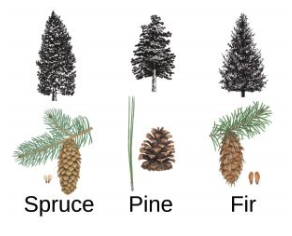
When it comes to firewood, the distinction between hardwoods and softwoods is crucial. Softwoods ignite more quickly, making them excellent for use as fire starters. On the other hand, hardwoods burn at a slower and more sustained pace, making them the ideal choice for adding to the fireplace before retiring for the night. The difference in burn rates between these two types of wood allows for strategic use based on specific needs, whether it’s for quickly establishing a warm fire or ensuring a longer-lasting source of heat.
*Important note: If stacking large amounts of firewood outside it should not be moved to different locations, only kiln dried firewood will prevent the spread of EAB Emerald ash borer to near by ash trees.
Understanding how to identify different tree species is crucial when planning to plant a new tree in your landscape or consulting an arborist about pests and diseases that may impact them. If you’re considering planting trees near your home, Splintered Forest Arborists can assist in selecting the best trees for your property. With a Plant Health Care assessment, we can help you make informed decisions about tree planting. Contact Splintered Forest Plant Health Care today to schedule a free estimate for your tree planting needs.
Sources:
*https://www.extension.iastate.edu/news/2005/nov/061401.htm
Planting fruit trees in Colorado can be incredibly rewarding, but the unique climate and growing conditions require careful planning and maintenance. With the right tree selection, proper pruning techniques, pest management strategies, and ongoing care, you can enjoy fresh fruit from your own backyard for years to come.
Pruning your fruit trees is a key part of caring for your fruit tree.
Mature trees: Maintaining good airflow and structure in older trees is the most important thing. Over pruning can be harmful to your tree so keeping cuts to a minimum and avoiding unnecessary cuts is the goal.
Young trees: Young trees are easier to work with in terms of pruning because of their faster growth patterns and lack of older mature branches. Young trees can also be pruned to fit specialty structure methods like espalier.
Fruit trees can be difficult to care for in terms of diseases and pests as some varieties are prone to common diseases like fireblight and cytospora canker. These diseases can add extra cost to the care of your trees, but are avoidable if you care for your tree properly. Preventative sprays can help to mitigate repeat infections from fireblight in the chance that your tree becomes infected, but the best method for protection is timed pruning in the dormant season.
Fruit trees do not bear fruit right away – in most cases it will be about three years until the tree begins bearing fruit.
Some tree varieties are susceptible to fireblight which is a bacterial disease so additional costs to protect them may be necessary.
Fruit trees grow relatively slow so they will need extra care for the first few years after planting.
Fruit trees should only be pruned when the tree is dormant unless absolutely necessary.
Proper fertilization of your fruit trees can improve health and fruit production.
Pruning is one of the most important steps in maintaining the health and productivity of your fruit trees. It helps shape the tree, encourage better fruit production, and prevent disease by improving airflow and sunlight penetration. However, improper pruning can do more harm than good, so it’s important to follow best practices based on the tree’s age and growth stage.
Older fruit trees require pruning to maintain structure, reduce overcrowding, and ensure that branches get adequate airflow and sunlight. Without proper pruning, excessive growth can lead to weaker limbs, reduced fruit production, and increased susceptibility to disease.
Pruning young trees is essential for developing strong branch structure and establishing a solid foundation for future growth. Young fruit trees tend to recover quickly from pruning and can be shaped using specialty techniques.
Pruning should always be done during the dormant season (late winter to early spring) before new growth begins. Summer pruning is only recommended for removing minor deadwood or shaping the tree slightly.
Colorado’s climate can present challenges for fruit tree growers, particularly when it comes to common pests and diseases. Many fruit tree varieties are susceptible to bacterial and fungal infections, as well as insect infestations, so proactive care is essential.
Regular monitoring, proper pruning, and well-timed applications of organic or chemical treatments can keep fruit trees healthy and productive.
Before planting a fruit tree, it’s important to set realistic expectations. Unlike vegetable plants or fast-growing shrubs, fruit trees require patience and long-term care before they produce a harvest.
If you’re considering adding fruit trees to your landscape, here are some best practices for planting and establishing strong trees:
Fruit trees are an investment, but with proper care, they can provide decades of fresh, homegrown fruit. If you need guidance on planting, pruning, or pest management, our arborists can help you every step of the way.
Whether your tree is mature or you’re looking into planting a new fruit tree, making sure your tree is healthy and free of pests and diseases will help to ensure your tree doesn’t die and produces plenty of fruit.
Next, learn more about how to stabilize a leaning tree. Discover the best practices for growing healthy fruit trees in Colorado’s unique climate with Growth Regulators. We have helped many customers with their tree problems in Colorado, but you don’t have to take our word for it. Visit Splintered Forest Customer Testimonials page to see what our customers are saying. Contact the team at Splintered Forest today to create a treatment plan today!
If you’ve got a dead tree in your yard, such as a silver maple, it’s almost always a good idea to remove it. Especially if it’s a big tree, your best bet is to call a tree removal company in Denver.
This can be a difficult decision sometimes; people often development attachments to trees—particularly big old ones—and it can be an emotional experience to see it chopped down, dug up, and taken away.
But there can be a lot of problems surrounding a dead tree that people often don’t consider. If a tree such as a silver maple is diseased or dying in a natural area, such as a forest, it can be left alone without worry about what it might damage. A tree located in a yard, however, might pose a danger to property and it might be an open invitation to pests.
Let’s take a look at what questions you should ask yourself in determining that it’s a good idea to remove a dead silver maple or other tree from your yard.
If there is trunk damage, such as cracks and seams, this means there was internal decay of the tree and it is more susceptible to falling.
If so, this is an open invitation to insects and rodents. It might not sound like a bad idea if rats take up residence in your dead tree, but if they run out of food outside, they might turn to the inside of your home in search for more.
Large branches on a dead tree can snap with ease in the event of a large wind- or snowstorm. What lies beneath the tree could well be damaged.
A dead tree that is near power lines is an accident just waiting to happen. The branches could fall on the power lines and knock out the power to your entire neighborhood.
If a large dead tree has branches that hang over your house or garage—or your neighbor’s house or garage—this could cause a lot of property damage in the event of a branch coming down. With Splintered Forest’s expertise, you can get the tree down before it causes damage.
And even worse than property damage: a falling branch hits a person who just happens to be walking in the wrong place at the wrong time. In either case, guess who will have to pay for damages and/or medical bills? (Here’s a hint: It’s not going to be the silver maple!)
Do you need a dead silver maple or other tree removed from your yard? Splintered Forest is a leading tree service company proudly serving residents in the Denver metro area and neighboring communities, including Evergreen. Our crew includes ISA certified arborists, former firefighters, experienced tree climbers, and expert tree fellers who work hard to give our customers the best service possible. Contact us today to schedule your free, no-obligation estimate in the Denver area or in Evergreen.
Get a Tree Removal Estimate from Splintered Forest.
If you’ve got a dead tree in your yard, such as a Silver Maple, it’s almost always a good idea to remove it. Especially if it’s a big tree, your best bet is to call a tree removal company in Denver.
This can be a difficult decision sometimes; people often develop attachments to trees—particularly big or old ones—and it can be an emotional experience to see it chopped down, dug up, and taken away. But there can be a lot of problems surrounding a dead tree that people often don’t consider. If a tree such as a Silver Maple is diseased or dying in a natural area, such as a forest, it can be left alone without worry about what it might damage. A tree located in a yard, however, might pose a danger to property and it might be an open invitation to pests.
Let’s take a look at what questions you should ask yourself in determining that it’s a good idea to remove a dead Silver Maple or other tree from your yard.
If there is trunk damage, such as cracks and seams, this means there was internal decay of the tree and it is more susceptible to falling.
If so, this is an open invitation to insects and rodents. It might not sound like a bad idea if rats take up residence in your dead tree, but if they run out of food outside, they might turn to the inside of your home in search for more.
Large branches on a dead tree can snap with ease in the event of a large wind or snowstorm. What lies beneath the tree could well be damaged.
A dead tree that is near power lines is an accident just waiting to happen. The branches could fall on the power lines and knock out the power to your entire neighborhood.
If a large dead tree has branches that hang over your house or garage—or your neighbor’s house or garage—this could cause a lot of property damage in the event of a branch coming down. With Splintered Forest’s expertise, you can get the tree down before it causes damage.
And even worse than property damage: a falling branch hits a person who just happens to be walking in the wrong place at the wrong time. In either case, you as a homeowner will be responsible for the damage and/or medical bills.
Do you need a dead Silver Maple or other tree removed from your yard? Splintered Forest is a leading tree service company proudly serving residents in the Denver Metro Area and neighboring communities, including Evergreen. Our crew includes ISA certified arborists, former wildland firefighters, experienced tree climbers, and expert tree fellers who work hard to give our customers the best service possible. Contact us today to schedule your free, no-obligation estimate in the Denver area or in Evergreen.